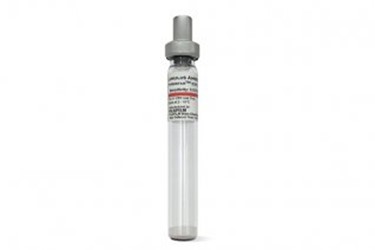Pyrostar ES-F Single Test Vial

Single Test Vial
Intended Use: Limulus amebocyte lysate (LAL) is intended for the detection of gram-negative bacterial endotoxins. PYROSTAR™ ES-F is intended for the qualitative detection of endotoxins by gel-clot or quantitative detection by kinetic turbidimetric methods. The quantitative range for the Kinetic Turbidimetric Assay (KTA) is based on the lysate gel-clot labeled sensitivity, refer to the table below:
| Gel-clot Labeled Lysate Sensitivity (EU/mL) | KTA Quantitative Range (EU/mL) |
| 0.015 | 0.001 to 10 |
Summary And General Information
Endotoxin (lipopolysaccharide or LPS) is a component of the outer membrane of Gram-negative bacteria. Since endotoxins, when injected or implanted, may cause fever and/or shock, the detection of bacterial endotoxins in pharmaceuticals and medicals devices is critical.
The LAL assay is the most sensitive method for the detection of bacterial endotoxins currently approved by the FDA.2 The first methodology used to determine the LAL test results was the formation of a gel-clot in the bottom of a glass reaction tube. It has also been observed that the test solution becomes turbid prior to gel-formation. The time required to produce a specified level of turbidity is inversely proportional to the amount of endotoxin in a sample.1
A photometric instrument such as the Toxinometer (Wako Pure Chemical Industries, Ltd.) is used to measure the rate of turbidity change. This quantitative measurement procedure is often referred to as the Kinetic Turbidimetric Assay (KTA).
By utilizing these properties, Wako Chemicals USA has developed an LAL endotoxin test that can be used either as a quantitative turbidimetric test or as a qualitative gel-test.
The USP Bacterial Endotoxins Test <85>6 provides standardized procedures for validation prior to routine use.
However, the specificity of LAL is not absolute.7 It has been reported that LAL reacts not only with endotoxin by also with β-1,3-glucan. Although the cascade system activated by β-1,3-glucan has been shown to be different than the one activated by endotoxin8, the end result, gel-clot formation is indistinguishable.
The activation of LAL by glucan in a sample can be prevented by adding a large amount of carboxymethylated curdlan (CMC) to LAL. The presence of large amounts of glucan does not interfere with the quantitation of endotoxin. Wako first made use of these findings by developing an ES-buffer, which contains high concentrations of CMC. When the ES-buffer is used to reconstitute LAL, the LAL reagent becomes endotoxin-specific. PYROSTAR™ ES-F is a new preparation of LAL in which CM-curdlan is colyophilized with LAL. Reconstituting PYROSTAR™ ES-F single test vials with sample results in an endotoxin-specific LAL reagent.
History And Biological Principle
The in-vitro detection of bacterial endotoxin was pioneered by Levin and Bang.3 Their findings showed that the blood of the horseshoe crab, Limulus polyphemus, clots in the presence of gram negative bacteria. They subsequently reported that all the components required for clot formation could be isolated from the circulating amebocytes found in Limulus blood.3,4
A guideline was released by the U.S. Food and Drug Administration in 19875 to inform manufacturers of human drugs and biologicals, animal drugs, and medical devices of procedures that FDA considers necessary to validate the use of LAL as an end-product endotoxin test. The FDA guideline was combined with the USP Bacterial Endotoxins Test in 2000 making the USP method the standard method for US manufacturers. The 1987 FDA Guideline was withdrawn in 2011.
Warnings And General Precautions
PYROSTAR™ ES-F is intended for the in-vitro detection of gram-negative bacterial endotoxins. Exercise caution when handling LAL because its toxicity is unknown.
This test is not a diagnostic device and is not to be used to determine endotoxin levels in humans for diagnostic purposes.
